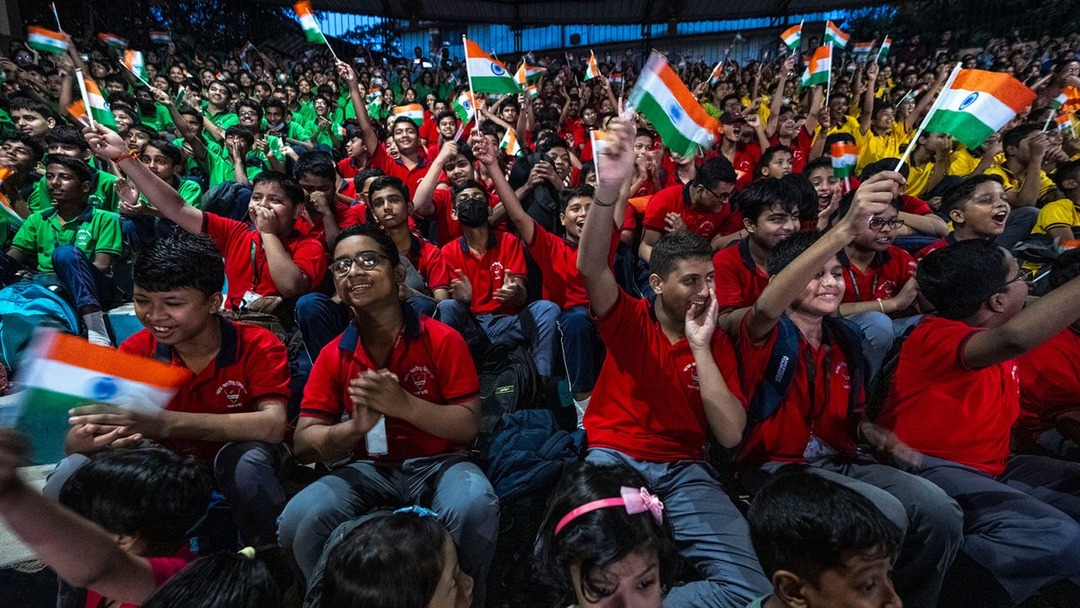(
CNN —
India has landed its Chandrayaan-3 spacecraft on the moon, becoming only the fourth nation ever to accomplish such a feat.
The mission could cement India’s status as a global superpower in space. Previously, only the United States, China and the former Soviet Union have completed soft landings on the lunar surface.
Chandrayaan-3’s landing site is also closer to the moon’s south pole than any other spacecraft in history has ventured. The south pole region is considered an area of key scientific and strategic interest for spacefaring nations, as scientists believe the region to be home to water ice deposits.
The water, frozen in shadowy craters, could be converted into rocket fuel or even drinking water for future crewed missions.
India’s attempt to land its spacecraft near the lunar south pole comes just days after another nation’s failed attempt to do the same. Russia’s Luna 25 spacecraft crashed into the moon on August 19 after its engines misfired, ending the country’s first lunar landing attempt in 47 years.
Chandrayaan-3’s journey
As Chandrayaan-3 approached the moon, its cameras captured photographs, including one taken on August 20 that India’s space agency shared Tuesday. The image offers a close-up of the moon’s dusty gray terrain.
India’s lunar lander consists of three parts: a lander, rover and propulsion module, which provided the spacecraft all the thrust required to traverse the 384,400-kilometer (238,855-mile) void between the moon and Earth.
The lander, called Vikram, completed the precision maneuvers required to make a soft touchdown on the lunar surface after it was ejected from the propulsion module. Tucked inside is Pragyan, a small, six-wheeled rover that will deploy from the lander by rolling down a ramp.
Vikram used its on board thrusters to carefully orient itself as it approached the lunar surface, and it slowly throttled down its engines for a touchdown just after 6 p.m. IST (8:30 a.m. ET) as applause erupted from the mission control room.
The Indian Space Research Organization, or ISRO, later confirmed it had established two-way communication with the spacecraft and shared the first images of the surface captured during the lander’s final descent.
The lander, which weighs about 1,700 kilograms (3,748 pounds), and 26-kilogram (57.3-pound) rover are packed with scientific instruments, prepared to capture data to help researchers analyze the lunar surface and deliver fresh insights into its composition.
Dr. Angela Marusiak, an assistant research professor at the University of Arizona’s Lunar and Planetary Laboratory, said she’s particularly excited that the lunar lander includes a seismometer that will attempt to detect quakes within the moon’s interior.
Studying how the moon’s inner layers move could be key information for future endeavors on the lunar surface, Marusiak said.
“You want to make sure that any potential seismic activity wouldn’t endanger any astronauts,” Marusiak said. “Or, if we were to build structures on the moon, that they would be safe from any seismic activity.”
The lander and rover are expected to function for about two weeks on the moon’s surface. The propulsion module will remain in orbit, serving as a relay point for beaming data back to Earth.
A global moon rush
Working alongside allies such as the United States and France, India is part of a second wave of emerging space powers. The country’s space program has become one of the world’s busiest in its development of exploratory space technology.
Chandrayaan-3 has been a point of national pride and widespread interest across India. Crowds gathered at the launchpad at Satish Dhawan Space Centre in Sriharikota in Andhra Pradesh state to watch the mission take flight in July. On Wednesday, more than 8 million people tuned in to view a livestream of the landing.
At least 500 people gathered at India’s Council of Scientific and Industrial Research in New Delhi Wednesday where the livestream was broadcast in an auditorium as well as outdoors at a temporary pavilion. After a successful touchdown was confirmed, Indian sweets were distributed to the audience, firecrackers were lit and spectators applauded for more than a minute.
Chants of “Bharat Mata Ki Jai” — or “victory to India” — could be heard, and children joyously waved the Indian flag.
More than a dozen countries have plans for missions to the moon in the coming years, including a mission launched by Japan’s space agency — the Japan Aerospace Exploration Agency — that is expected to lift off later this month. The United States also has plans to send three commercial lunar landers to the moon starting as early as this year, while NASA continues to work toward its Artemis III mission, which could put astronauts back on the moon as soon as 2025.
Landing on the moon, however, remains a challenging endeavor. India’s last attempt to land a spacecraft on the moon, during the 2019 Chandrayaan-2 mission, failed. And two commercial spacecraft have crash-landed on the lunar surface in recent times — one from Israel in 2019 and the other from Japan in April.
“There is no doubt that landing on the Moon is a real challenge,” NASA Administrator Bill Nelson said in a statement on Sunday. “But the Moon offers great scientific reward, which is why we’ve seen so many recent attempts to visit the surface again. We’re looking forward to all that we will learn in the future, including from India’s Chandraayan-3 mission.”
On Wednesday, Nelson also shared a congratulatory note on social media, saying, “congratulations to #India on being the 4th country to successfully soft-land a spacecraft on the Moon. We’re glad to be your partner on this mission!”
India is also a signatory of the United States’ Artemis Accords, a document that outlines proposed rules of the road for future lunar exploration. Russia and China have not signed the accords.
source: https://edition.cnn.com/2023/08/23/world/chandrayaan-3-lunar-landing-attempt-scn/index.html




